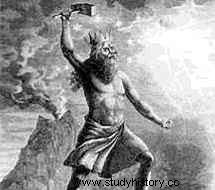The Scandinavian legends and myths of ancient gods or heroes and the creation and destruction of the universe developed outside the original mythology common to all Germanic peoples and constitute the first source of knowledge of ancient Germanic mythology. Because Scandinavian mythology was handed down and altered by medieval Christian historians, the original religious beliefs, attitudes and practices cannot be defined with certainty. However, it is clear that Scandinavian mythology developed slowly and the relative importance of the various gods and heroes differed according to times and places. Thus, the cult of Odin, ruler of the gods, may have spread from western Germany to Scandinavia not long before the myths were recorded; Minor gods, including Ull, the fertility god, Njord and Heimdall, may represent older deities who must have lost popularity and diffusion as Odin became more important. Odin, god of war, was also associated with knowledge, wisdom, poetry and magic.
Along with Odin, the most important deities in Scandinavian mythology were his wife, Frigg, goddess of the home; Thor, god of thunder, protector of humans and other gods against giants, was especially popular with Scandinavian peasants; Frey, god of prosperity; and Freya, sister of Frey, goddess of fertility. Minor gods were Baldo, Hermond, Tyr, Bragi, and Forseti; Idun, Nanna and Syf were among the goddesses. The principle of evil among the gods was represented by the swindler Loki. It does not appear that many of these deities had special functions; they simply appear as characters from legends.

Thor was the god of thunder and the supreme creator in Scandinavian mythology. He brandished a hammer called Mjollnir, which represented the power of lightning. When thrown, it returned to him like a boomerang
Many ancient mythological heroes, some of whom appear to have derived from real people, were believed to be descended from gods; among them were Sirgud the Dragon Slayer, Helgi Threefold, Harald Wartooth, Hadding, Starkad, and the Valkyries. These were a group of female warriors, which included Svava and Brunhilda; they served Odin as selectors of dead warriors, whom they converted into Valhalla's dwellers. There the warriors spent their days fighting and their nights rejoicing until Ragnarok, the day of the Universe's final battle, the date when the old gods would perish and a new reign of peace and love would be instituted. The goddess Hel welcomed ordinary people after death into her melancholy hellish world.
Scandinavian mythology included dwarves, goblins, and the norns, who dealt lots among mortals. Ancient Scandinavians also believed in personal spirits, such as the ylgja and hamingja, which in some ways resembled the Christian idea of the soul. Originally, the gods were conceived as a confederation of two divine tribes, warriors at first, the Aesir and the Vanir. Odin was the leader of the first, which comprised at least twelve gods. All the gods lived together in Asgard.
German Civilization
